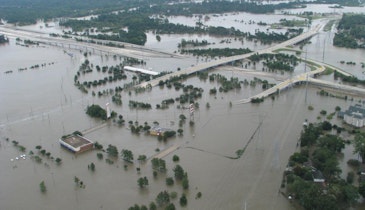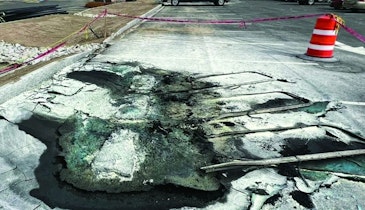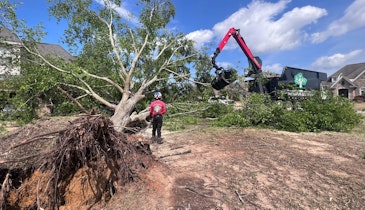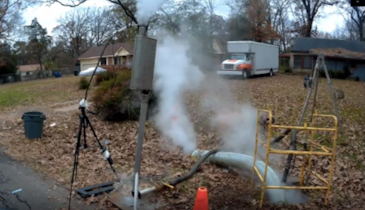
Staff made changes to a backup process pump so it can be used to send mixed liquor suspended solids directly to a chlorine contact chamber if necessary during a high-flow storm event.
Interested in Safety?
Get Safety articles, news and videos right in your inbox! Sign up now.
Safety + Get AlertsBy their nature, wastewater treatment plants that service coastal communities are vulnerable to storm surges and floods.
The town of Hull, Massachusetts, on a peninsula at the southern edge of Boston Harbor, is particularly at risk. Surrounded by the Atlantic Ocean on two sides with a front door elevation of 12 feet, the Hull Water Pollution Control Facility has been affected by several major storms over the last 40 years, including major townwide floods.
Upon entering a 10-year contract to operate Hull’s treatment plant in 2015, Woodard & Curran sought to change the facility’s mindset about storms and wet-weather events. With a few key initiatives centered around a mock storm drill, the facility has shifted its reactive approach to a proactive program that uses every storm as an opportunity to improve its resiliency and emergency response plans.
Getting ready
The town of Hull, a community of about 10,000 with some 15,000 seasonal residents, lies between Hingham Bay and Massachusetts Bay on the south shore of Massachusetts. The sewer system includes about 42 miles of separated gravity sewers, seven wastewater pumping stations and more than 175 publicly owned grinder pumps within the low-pressure sewer system. The water pollution control facility receives flow from the neighboring towns through a sewer utility Inter-Municipal Agreement and discharges to Massachusetts Bay, regulated under a National Pollutant Discharge Elimination System permit.
Storms and nor’easters have flooded portions of the plant, causing mechanical issues that led to lost power and partial or complete treatment bypass for several days. While operators have become experts in responding to wet-weather events, they were often too consumed with urgent repairs after major storms to reflect on how to better prepare for the next one. As a result, the same failures experienced during the last storm would often flare up during the next one. Woodard & Curran’s objective on taking over operations was simple, yet daunting: Make the vulnerable facility not just responsive, but resilient to high-flow events.
To the test
Woodard & Curran team members updated the town’s high-flow management plan as it began to implement comprehensive storm event planning. To evaluate the plan’s effectiveness, they decided to run a mock storm drill instead of waiting for a real storm. The drill setup was simple, but it brought forth inefficiencies and gaps in the plan, giving operators a chance to refine their preparedness before the upcoming hurricane season.
The first step of the drill was to bring all the stakeholders together to discuss each of the key shared facilities, shared resources and key contacts that were fundamental to the high-flow management plan. During this step, the group discussed previous storms and potential damage future high-flow events might bring.
While Hull had plenty of previous storms to use as historical guidance, it is important for facilities to think big about storm outcomes while developing management plans. To help identify the critical concerns to be addressed, team members asked such questions as:
- What if the entire town loses power?
- What if we can’t access the typical regional sources?
- What can we store on site in advance?
- Which community members will need us to support them?
A few weeks after the initial meeting, the wastewater treatment staff and other support staff from the region met at the Hull facility to kick off the mock drill. It began with a morning tailgate meeting where participants were assigned partners and duty checklists.
The mock storm scenario was a Category 5 hurricane making landfall at the facility. The teams dispersed to their assigned areas to run through the drill. To make it feel as immediate as possible, all tasks that could be simulated without disrupting normal operations were actually performed. For example, where the procedures called for physical inspection of a manhole, the team assigned to that task found the asset and performed the inspection.
Radios were the main form of communication for questions during task assignment, and floater assistance staff took photos of the activities. Midday, participants executed their tasks; over lunch, everyone came together to deliberate about the ease of task execution. The afternoon was spent walking through recommendations and concerns observed by visiting operations team members.
Making improvements
Small changes can make big impacts in an emergency, and through the mock storm drill, Hull picked up on several process improvements and gaps in the initial plan. Here are some of the improvements made after the storm drill:
Assembling stakeholders
The simple act of bringing everyone together, whether during the preplanning meeting or the drill itself, strengthened the response plan. It pulled relevant parties in to play active roles in implementing the plan before a crisis hit. Having nonfamiliar staff take part in the drill led to better outcomes and better perspectives on obvious improvements. Through the storm, the treatment facility staff developed a much closer relationship with the Fire Department, opening the door for knowledge sharing between these two critical emergency response departments.
Team-sized information delivery
The original plan provided one master checklist for activities before, during, and after the storm, but during the drill, it became clear that this format was not helpful in the field. In practice, people on the ground wanted to divide and conquer the steps outlined in the plan, but it was more effective to break up essential tasks into smaller, team-sized procedures with photos and safety tags. Several storm response team members were not regular facility employees, and they highlighted how the checklists and standard operating procedures should be written so that anyone helping the facility could confidently handle the assigned tasks.
Make critical field elements easily identifiable
During the drill, it became apparent that some critical assets that needed to be maintained and monitored during a storm were not as identifiable as they should be. After the first drill, the facility staff made simple changes to some of the assets. For example, they painted the electrical manholes red and the process manholes green so that emergency staff could easily distinguish between the two.
Shifting the utility mindset
To move any hazard mitigation plans from tabletop to the teams on the ground, facilities must start somewhere. While a mock storm drill may seem complicated to plan and execute, the act of playing out plans before a crisis hits will improve a facility team’s response to any potential hazard, whether storm, earthquake, or wildfire.
Since the storm drill, the Hull facility has adopted a culture of continuous improvement by empowering operators to identify and implement constructive changes after every storm. The relationship established between the Fire Department and the treatment facility staff has led to the departments joining forces, hosting joint training exercises. The facility team adopted a more formal observation program during storms that has helped document vulnerabilities and areas of improvement.
As Hull’s mindset for storms and wet-weather events has shifted, and so has its approach to funding and upgrades: It has made resiliency a priority. The Massachusetts State Revolving Fund recently awarded the town $10 million in loans to make capital improvements for safety and facility resiliency at pump stations and the treatment facility.
About $2 million has been reserved to complete a reliability centric-maintenance assessment of the facility and resiliency planning. These planning projects — along with $8 million in collections system resiliency improvements for infiltration/inflow/exfiltration prevention — demonstrate the town’s focus on building more resilient facilities and improving return-to-operation time after major storms occur.
A community’s response and resiliency during natural disasters will increase when facilities and their stakeholders take time to find the cracks in their emergency response plans and fill them in together. By practicing and perfecting the response, the Hull team will be prepared to keep its community and the water pollution control facility safe under the most intense conditions.
About the authors
Bill Boornazian, bboornazian@woodardcurran.com, is the assistant plant manager with Woodard & Curran at the wastewater treatment facility in the town of Hull, Massachusetts. John Struzziery, jstruzziery@town.hull.ma.us, is director of wastewater operations and assistant director of Public Works in the town of Hull.
This article was originally posted September 2018.





